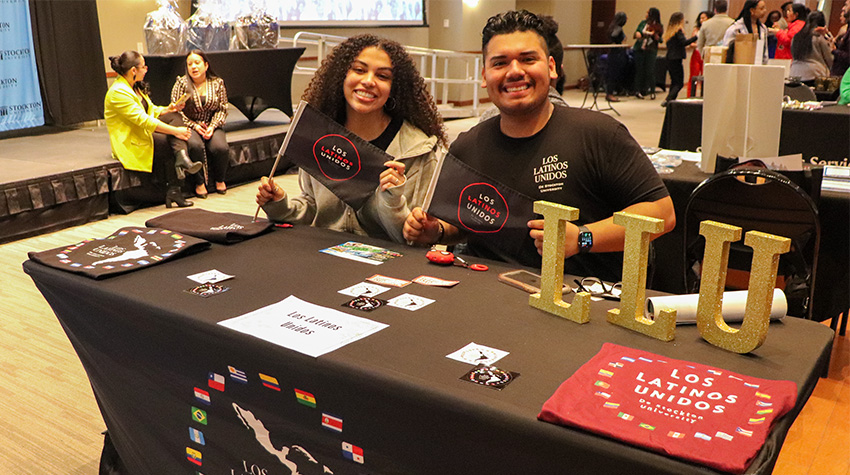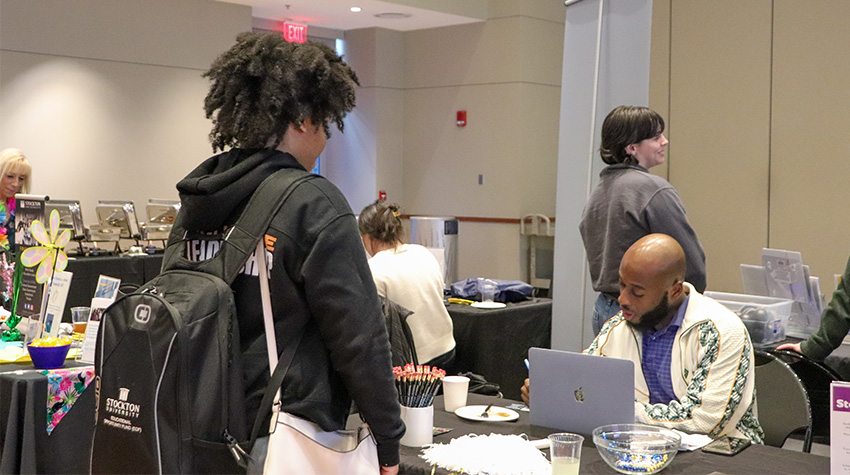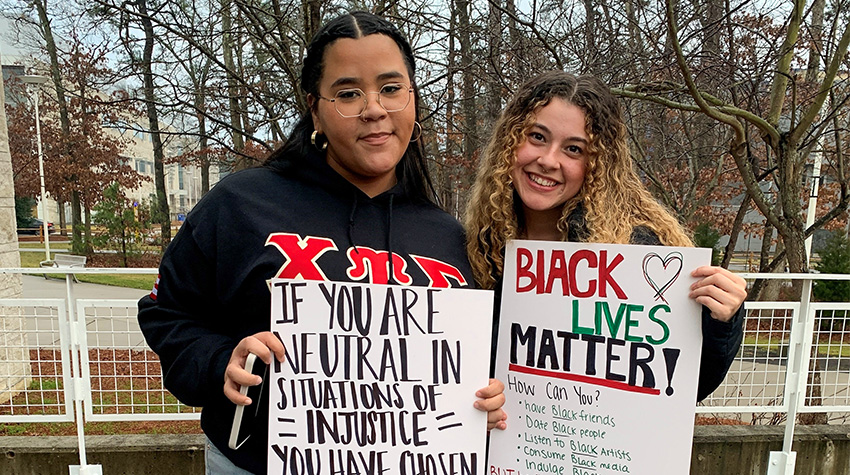Restorative Justice: Key for Understanding Multilayered Students
By Loukaia Taylor, ’22
Yesenia Pacheco, newly minted coordinator for Student Transition, Access and Retention, recently concluded her internship with the Office of Student Conduct by hosting the first Restorative Justice Summit on April 19.
The summit, as described by Pacheco on her website, was created to be an “educational forum that brings together students, faculty and staff to collaborate in advancing equitable, evidence-based restorative justice and peacemaking practices.”
Below is a video explaining the concept of restorative justice, shown during the summit, and an interview with Pacheco about the summit and what lessons she hopes that participants will walk away with.
What inspired the summit?
So specifically, my personal story is that I went through my own code of conduct kind of situation as a sophomore and it made me realize how much work our restorative justice process at Stockton needed. However, I didn't think I would be a part of that change.
Honestly, it actually took a meeting with (Seth) Richards (associate director of the Office of Student Conduct), and he wound up telling me about his philosophy when he first came to Stockton, and I was like, wow, that's the same philosophy I share. I started sharing my vision for what I wanted that restorative justice process to look like in our conduct system because during my process I had nothing.
I was a first gen Latina, confused, lost and shamed. I felt like, you know, like, I can't believe I messed this up. All my sisters are looking up to me because I'm the first one to go to school and I just was like, really beating myself up (over the situation). That's when I realized that our process shouldn't be like this; we shouldn't have students kind of backed into a corner, confused and not knowing what the next steps are or how they can improve from this situation. We should be showing them that mistakes can be learned from, and these are the same values that Mr. Richards had.
So, after talking about this and being an intern in his office, I really felt like we needed to have a big, large-scale event that showed how impactful the restorative justice approach is when we integrate it with students and how it shows not only a decrease in conduct violations but also an increase in (positive) perceptions of the Office of Student Conduct and many of the offices that we collaborate with, like the Stockton Center for Community Engagement & Service Learning, the Women's Gender & Sexuality Center, CARES or even Residential Life.
It’s our role as faculty and staff members to really, like, take that extra time to ask our students how they’re doing and not just think that our role is solely just to teach and educate. There are other components to our role and tasks – it’s very multilayered, like our students and their problems."Yesenia Pacheco, coordinator for Student Transition, Access and Retention
Can you elaborate on how restorative justice relates to Stockton University’s ‘students first’ motto?
So, the way I see it, restorative justice is like what Dr. Maya Lewis said; not just saying “I’m sorry for what I did,” but also saying, “How can I repair the harm that I did and make sure that this doesn't happen again?”
So, when we apply that philosophy to our students who are going to commit code of conduct violations or make mistakes – especially students from marginalized groups who aren't really connected to a lot of the things that make them not want to commit those mistakes – we're like, “Okay, how are we going to move forward?”
It means you're looking at the student and you're not thinking, “Well, I'm going to fine them,” or “I'm going to put them on an interim suspension.” Because what is that really doing for the student who may not be able to continue their academic career if we suspend them or be able to pay this fine?
When we apply this philosophy, it's like we're thinking about different outcomes that students will actually learn from like, projects, service-learning opportunities and making them attend certain enrichment opportunities like the Glow Up Opportunity Fair (pictured below) and Career Education & Development’s annual Career and Internship Fairs.
Students should understand the impact of what they did and then gain the knowledge, skills and resources to move forward and better themselves as a student.





I appreciate you mentioning Maya Lewis’ example of restorative justice; you had some really phenomenal speakers for the program. Can you tell us why you chose those specific speakers?
William E. Reynolds, Atlantic County Prosecutor
Well, Seth was fortunate enough, actually, like he said during the program, to run into him at Starbucks. But during that Starbucks interaction, (Reynolds) really started laying out all of his mindset when it came to restorative justice, especially in the court process. He was very transparent when it came to the perceptions that he knows that a lot of the public has when it comes to police officers.
It was very inspirational to me how he was willing to roll up his sleeves and do the work on his own independently if it meant that that was going to free him from bias and discrimination and that he was actually going to get the answers that he was looking for; the first year he was in office, he wound up doing around 31 Internal Affairs investigations on his own officers, which shows you the commitment and the determination that he has for getting answers for our community.
I've also always been interested in crime and the criminal justice system: I have a degree in Criminal Justice, but I felt like I couldn't go into it because their mindset tends to be the police world versus the community. But now, we're seeing how he's integrating that police world into the community and that's something that we've never really been able to see throughout history. I thought his story would be inspirational.
Maya Lewis, associate professor for Social Work
As for Maya Lewis, I was very intentional about inviting her because I’ve had her as a student and I see how she’s able to have this restorative justice mindset when it comes to her students: she's willing to have those extra meetings, have students come to her office hours or talk through email.
She's like, “I know you're going to turn in work and understand the material, but you're going through other things that are affecting (your academics), so let's come together and think of how you can successfully pass this class with a grade that is acceptable, but at the same time it's not taking away from all of these other personal things that you might have going on as a student.”
And she was one of the first professors that I've seen have this type of mindset and to just be so transparent and compassionate when it comes to her students and their willingness to succeed. It showed me how important it was for faculty members to have this philosophy, especially when we talk about restoring students inside the classroom and transforming students outside the classroom, too.
Aleyshka “Ale” Barbosa, senior Social Work major and president of First Ospreys
Lastly, I was very touched by Ale’s (conduct violation) story – I saw someone who kind of went through a similar situation as me in terms of going through the code of conduct violation, having that violation, you know, thinking, “This is my biggest mistake. I messed up my college career. Like, I can't believe I have to call my mom and explain this to her.” I remember going through the same emotions, and it was a hard time as a first-gen student just having to tell my mother that her baby, who was supposed to be setting the pace for her family, messed up.

It was very challenging for Ale, but to see how she used that and wound up becoming a TALON, then transitioning into becoming a head TALON was inspirational. And through those roles, she realized how important it was for her to use her platform to help others and spread the message of why it's important to have a restorative justice mindset.
For students, I felt like there was nobody else that could really show how impactful it is because she could have dropped out, or transferred schools and, like, ran from the situation. She could have decided she was going to stay home and that her college career was over, but, instead, she used that process as fuel to push herself in the right direction, which she did!
What do you hope that faculty and staff got out of the Restorative Justice Summit?
During the summit, we talked about all the layers that may be affecting a student personally, physically or mentally; for example, they may be dealing with mental health problems just from going through negative college experiences. Maybe the student has anxiety or depression and didn’t even know that they had the disorders or that it started to develop during their time here.
It’s our role as faculty and staff members to really, like, take that extra time to ask our students how they’re doing and not just think that our role is solely just to teach and educate. There are other components to our role and tasks – it’s very multilayered, like our students and their problems.
Loukaia Taylor is an alumna of the Communication Studies program and member of the Campus Committee on Diversity and Inclusive Excellence.
Related Articles:


